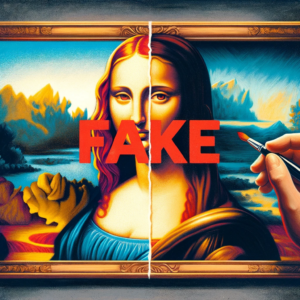The contemporary art market faces a worrying increase in artistic fraud, encompassing both counterfeiting and forgery[1].
For instance, in the Spies-Ernst scandal[2], a painting sold as an original Max Ernst was later unveiled as a forgery by Wolfgang Beltracchi, crafted with materials that were not available in Ernst’s era.
This incident highlights the sophisticated techniques employed by modern forgers and the significant challenges faced by experts in authenticating artworks. In response, the Conseil Supérieur de la Propriété Littéraire et Artistique’s (CSPLA – French Higher Council for Literary and Artistic Property)[3] report highlights the inadequacies within France’s existing legal statutes in combating these illegal practices, notably the 9 February 1895 law.
This scrutiny indicates a pressing need for an overhaul of the legal framework to enhance the safeguarding of artworks and their creators.
Sommaire
Current Legal Context
The Bardoux Law of 1895 stands as a foundational legal measure for combatting artistic fraud in France. Yet, its effectiveness is increasingly challenged by technological advancements and novel fraud techniques, including the exact replication of artworks. These activities, while not directly violating copyright laws, significantly compromise the integrity of the art market.
Proposals for reform:
- Towards the creation of an “artistic fraud” offence?
This report evaluates the bill adopted by the Senate on 16 March 2023, which aims to modernise the legal framework against artistic fraud. This reform proposal seeks to broaden the definition of “artistic fraud” to include all forms of illicit reproduction, increase criminal sanctions and create a more dissuasive repressive component.
Currently, the general laws in the Penal Code and the Consumer Code, covering fraud and deception, fall short in effectively combating art forgery. These laws lack specificity regarding art fraud, leading to legal ambiguity and a broad range of interpretations. This lack of clarity and the insufficient deterrent effect of existing penalties have made it easier for counterfeiters and their collaborators to evade serious repercussions. Consequently, the outcomes of legal actions against such individuals are often deemed inadequate, highlighting the need for more targeted and stringent measures.
-
Civil liability of the perpetrator of artistic fraud?
The primary recommendation of the mission is to implement fines that are tailored to the financial capacity of the fraudster and the severity of the offense. Furthermore, it advocates for categorizing organized artistic fraud as a crime that warrants specialized criminal procedures. Additionally, the proposal suggests enabling specific associations to participate as civil parties in legal actions concerning these offenses, aiming to strengthen the enforcement and legal response to artistic fraud.
Civil law can also be useful against artistic counterfeiting, but it is limited to certain aspects of the dispute.
For instance, contract law permits the annulment of sales if the work’s nature has been misrepresented, addressing the aftermath rather than directly sanctioning counterfeiting. To enhance this approach, the Mission suggests adding a civil dimension to the existing criminal framework. This addition would enable victims of artistic fraud to seek compensation for their losses, thereby providing a more comprehensive remedy for those affected by such fraud.
It is recommended that a provision be added to the French “Heritage” Code ‘Code du patrimoine[4] stating that “any artistic fraud entails the civil liability of its author”, thus clearly establishing the possibility of civil proceedings for the cases described in article L. 112-28, provided that fraudulent intent is proven.
Adapting to new technologies
A key point of the report is to adapt legislation to the challenges posed by digital technologies. Advances in artificial intelligence and the proliferation of online platforms facilitate the proliferation of fakes, making them more difficult to detect and combat. The report proposes the inclusion of specific measures to address the impact of new technologies on the art market.
- Artificial Intelligence (AI) Impact: the mission proposes a duty of transparency for AI applications in art creation, suggesting that regulations should mandate clear disclosure about the use of AI in both the creation and distribution phases of artworks.
- Digital Networks: The mission recommends encouraging soft law norms for online platforms to cooperate with rights holders, including setting up reporting mechanisms for counterfeit art. It also suggests legal measures to enable judges to order preventive actions against the online dissemination of fraudulent art.
- Non-Fungible Tokens (NFTs): The mission suggests applying existing laws to NFT-related art fraud while also recommending the development of certification mechanisms prior to NFT minting to enhance reliability and trust in digital art transactions.
These recommendations aim to adapt the legal framework to effectively counter the challenges posed by digital technologies in perpetuating art fraud.
Conclusion and outlook
The CSPLA report provides a solid basis for rethinking legislation in the light of technological developments and new forms of fraud. Implementing the recommendations would strengthen the effectiveness of protection and enforcement mechanisms and provide greater legal certainty for those involved in the art market.
Given the urgent need to reform the legal framework and protect the rights of creators, Dreyfus Law Firm stands ready to guide and support stakeholders through these evolving challenges.
Dreyfus & associés partner with an international network of Intellectual Property attorneys
Have your say: Follow us on social networks!
[2] https://ial.uk.com/the-spies-ernst-case-art-experts-in-france-can-breathe-a-sigh-of-relief/
[3] In France, the High Council of Literary and Artistic Property is an independent advisory body that advises the Minister of Culture and Communication on literary and artistic property. To read the report (in French) : https://www.culture.gouv.fr/Nous-connaitre/Organisation-du-ministere/Conseil-superieur-de-la-propriete-litteraire-et-artistique-CSPLA/Travaux-et-publications-du-CSPLA/Missions-du-CSPLA/Rapport-de-mission-sur-les-faux-artistiques
[4] For the purposes of this Code, heritage is understood to mean all property, whether immovable or movable, in public or private ownership, which is of historical, artistic, archaeological, aesthetic, scientific or technical interest.


